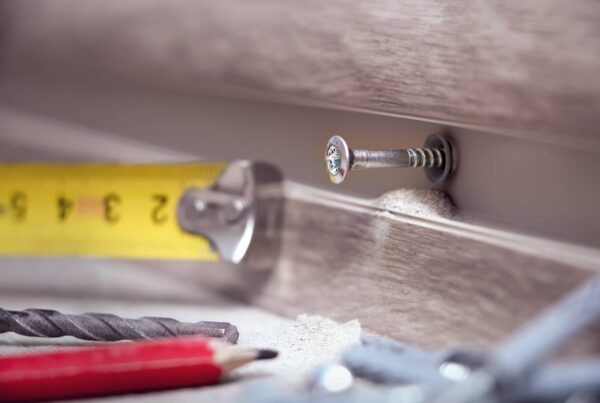
Every homeowner knows the importance of a ceiling fan that delivers optimal performance and seamlessly integrates with the room’s design. The perfect balance hinges on one crucial factor – appropriate sizing. Properly measured ceiling fans enhance comfort and contribute to the overall aesthetic appeal of a space.
In this guide, we’ll dive deeper into the importance of correct measurements, break the process into steps, and share expert tips for avoiding common sizing mistakes. Before long, you should be confident to select and care for a ceiling fan that perfectly complements any room while keeping you cool and comfortable.
Why it Matters
Accurate measurements are important to comfort, energy efficiency, and visual appeal. A too-small fan may struggle to provide adequate airflow, leaving you feeling warm and stuffy. On the other hand, an oversized fan can overwhelm the space, creating a distracting and unbalanced look while potentially wasting energy.
When a ceiling fan is properly sized for the room, it effectively circulates air, creating a comfortable and inviting atmosphere. This efficient airflow can even help reduce your reliance on air conditioning. This leads to lower energy bills and a more eco-friendly home.
Moreover, well-measured ceiling fans complement your room’s design, enhancing its overall aesthetic. Whether you prefer a modern or traditional style, the right fan will integrate with your decor as a functional focal point.
Incorrect sizing can also lead to mechanical issues. This can mean concerns such as wobbling or noise, which can diminish the fan’s performance and lifespan. When a ceiling fan is measured accurately, you’ll avoid these problems and ensure the fan operates smoothly and efficiently.

How to Measure Your Ceiling Fan
To ensure you select the perfect ceiling fan for your space, two key dimensions are critical – the blade span and the distance from the ceiling to the blades. Here’s a simple, step-by-step look at measuring like a pro.
Measuring the Blade Span
- Grab a sturdy, reliable measuring tape or laser measure for precise results.
- Identify the tip of one blade and extend your measuring tool to the tip of the opposite blade.
- Record this measurement, which represents the fan’s diameter or blade span.
- Double-check your measurement to ensure accuracy.
The blade span helps you determine the appropriate fan size for your room. As a general rule, larger rooms require fans with a greater blade span to ensure optimal air circulation. Use this helpful guide to match your room size with the ideal blade span:
- Rooms up to 75 sq. ft. – 29-36 inch blade span
- Rooms 76-144 sq. ft. – 36-42 inch blade span
- Rooms 145-225 sq. ft. – 44-50 inch blade span
- Rooms 226-400 sq. ft. – 50-54 inch blade span
Measuring the Distance from the Ceiling
1) Start from the ceiling and measure down to the bottom of the fan’s motor housing.
2) Record this distance. It should ideally be at least 7 feet for optimal airflow and safety.
3) If your ceiling is higher than 8 feet, consider using a downrod to achieve the proper blade height.
When measuring the distance from the ceiling, note any unique room features or layouts that may impact fan placement or size. For example, if you have a sloped ceiling, you may need to adjust your measurements or consider a specialized fan mounting kit.
Additional Considerations
- Blade Pitch – The angle of the fan blades can affect airflow. Fans with higher blade pitch (12-15 degrees) can move more air than those with lower pitch.
- Lighting and Accessories – If your fan includes a light fixture or other attachments, factor in the additional space required for these components.
Avoiding Potential Mistakes
Anyone can fall prey to common measurement mistakes if they aren’t careful. Here are a few pitfalls to watch out for and tips on how to avoid them.
Using Inaccurate or Unreliable Measuring Tools
Using stretched-out, old measuring tapes or eyeballing distances can lead to inaccurate measurements and sizing issues. Instead, always use a high-quality, reliable measuring tool, such as a sturdy measuring tape or laser measure. Also, regularly check your tools for signs of wear and tear, and replace them if necessary to maintain accuracy.
Not Considering Room Features and Layouts
Every room is unique, and failing to account for specific features or layouts can lead to sizing and installation issues. When measuring your ceiling fan, take note of any sloped ceilings, low-hanging light fixtures, or architectural elements that may impact fan placement or size. If you have a room with unusual dimensions or features, consider consulting with a professional to ensure you select the right fan for your space.
Ignoring Fan Blade Pitch and Accessories
While blade span and distance from the ceiling are the two most critical aspects of fans to be measured, ignoring things like blade pitch and additional accessories can impact your fan’s performance. Fans with higher blade pitch can move more air, which is essential for larger rooms or spaces with high ceilings. If your fan includes a light fixture or other attachments, make sure to factor in the additional space required for these components to avoid installation issues.

Other Recommended Maintenance
A few simple steps can keep your fan running smoothly and efficiently for years. Regular cleaning is essential to prevent dust and debris accumulation on the blades, which can cause imbalance and reduce airflow efficiency.
Use a soft cloth or duster to clean the blades and motor housing every few months, and slightly dampened microfiber cloths for tougher grime. Also, periodically inspect your ceiling fan for signs of wear and tear, such as cracks, chips, or warping on the blades, and ensure all screws and fasteners are securely tightened. Address loose or damaged parts promptly to avoid wobbling, noise, and safety hazards.
If you notice wobbling or unusual noises, consider balancing the blades by adjusting the blade clips or weights to ensure each blade is level and properly aligned. Balancing kits are available, but consulting with a professional is often best.
When to Call a Professional
One of the most common scenarios where professional help is recommended is during the initial installation process.
Ceiling fans require proper electrical wiring and secure mounting to ensure safe and efficient operation. If you’re unfamiliar with electrical work or lack the necessary tools and equipment, it’s best to leave the installation to an expert.
Another situation where professional assistance may be necessary is when you encounter complex maintenance issues or repairs. More intricate problems, such as motor malfunctions or electrical issues, require the expertise of a trained technician. Attempting to tackle these issues without the proper knowledge and tools can lead to further damage or even personal injury.
Finally, if you’ve followed all the recommended maintenance steps and your ceiling fan still isn’t functioning properly, it’s time to call in a professional. They can diagnose the issue and provide effective solutions to get your fan back in top shape.
Wrapping Up
Ultimately, properly measured and maintained ceiling fans retain the best performance and aesthetics. Investing effort in selecting and looking after your ceiling fan yields benefits like energy savings, enhanced comfort, and added visual appeal.
Remember to measure carefully, perform regular maintenance, and watch out for signs of wear. Equally important, never hesitate to reach out to an expert for help. For guidance with any of your house’s main systems or to schedule a complete home inspection, reach out to Alpha Building Inspections in NH, MA, and ME.



